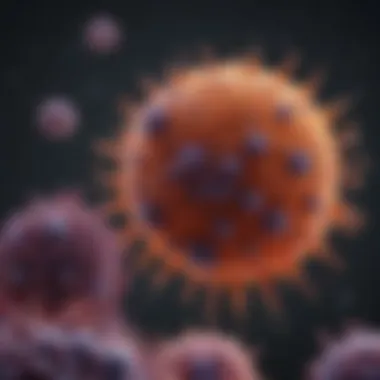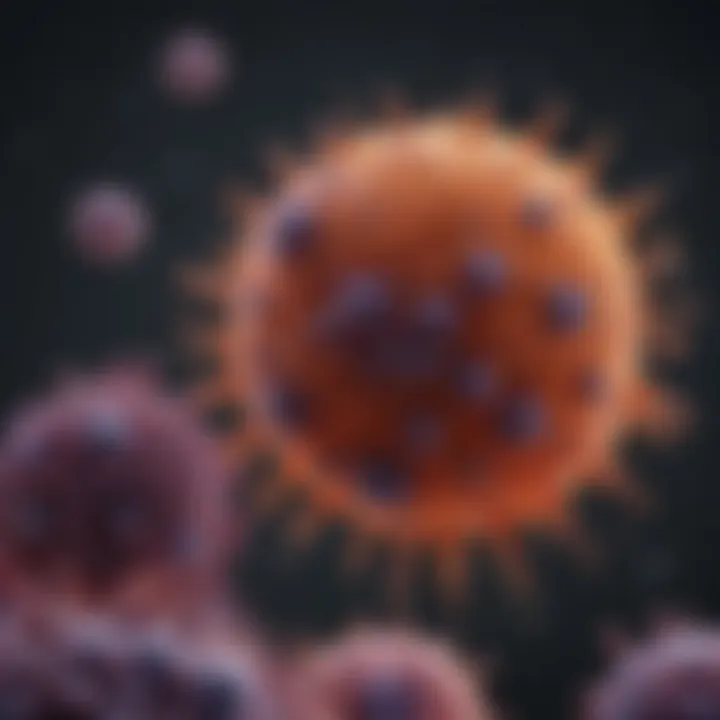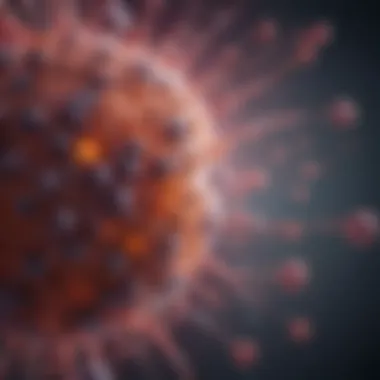Exploring T-Cell Dynamics in Hodgkin Lymphoma


Intro
Hodgkin lymphoma (HL) is a type of cancer that originates in the lymphatic system, particularly from lymphocytes. Understanding its intricacies is crucial for researchers and clinicians alike, given the rising incidences reported globally. This article aims to dissect the relationship between T-cells and Hodgkin lymphoma, shedding light on how immune components influence tumor behavior and treatment responses.
Overview of Research Topic
Brief Background and Context
Hodgkin lymphoma is classified as a malignancy of the lymphatic system, distinguished by the presence of Reed-Sternberg cells. It affects individuals of varying ages and can lead to severe health implications if not diagnosed and treated timely. The immune system plays a fundamental role in the pathology of HL, particularly by the involvement of T-cells. These cells are of two main types: CD4+ and CD8+, each having different effects on tumor dynamics. The interactions between these cells and the tumor microenvironment merit careful study to understand their implications fully.
Importance in Current Scientific Landscape
Research focusing on the relationship between T-cells and Hodgkin lymphoma offers insights that could redefine therapeutic strategies. As immunotherapies gain traction, recognizing the role of immune cells in tumor progression becomes increasingly relevant. The ongoing studies could illuminate potential avenues for treatment refinements and enhance patient outcomes.
Methodology
Research Design and Approach
This analysis will employ a systematic review of existing literature, including clinical trials and laboratory studies focused on Hodgkin lymphoma and T-cell interactions. The review aims to synthesize findings from various sources to present a coherent understanding of this area.
Data Collection Techniques
Data will be gathered from peer-reviewed journals, clinical trial databases, and reputable online resources such as Wikipedia and Britannica. Each source will contribute to a comprehensive overview, ensuring a diverse range of perspectives and findings are included.
"Recognizing the immune interactions in Hodgkin lymphoma is vital for developing targeted therapies that could alter treatment landscapes."
Through this investigation, we aim to highlight key findings and synthesize them into actionable insights for clinical application.
Preamble to Hodgkin Lymphoma
Hodgkin lymphoma is an essential area of research within oncology, as it presents unique challenges and insights into lymphatic system malignancies. Understanding Hodgkin lymphoma helps illuminate the intricacies of immune system interactions and their consequences for both tumor development and patient outcomes. The pathology of Hodgkin lymphoma is distinctly marked by the presence of Reed-Sternberg cells, which serve as an important indicator for diagnosis and prognosis.
Definition and Classification
Hodgkin lymphoma is classified primarily into two categories: classical Hodgkin lymphoma (CHL) and nodular lymphocyte-predominant Hodgkin lymphoma (NLPHL). CHL is more prevalent, representing about 95% of cases and is characterized by the presence of Reed-Sternberg cells. This classification is critical because it informs treatment approaches and helps healthcare professionals predict patient outcomes.
The subtypes of CHL can be further divided into several recognized histological forms, including:
- Nodular Sclerosis: The most common subtype, often affecting younger individuals, with characteristic bands of collagen.
- Mixed Cellularity: Frequently observed in older patients, associated with a higher burden of Reed-Sternberg cells.
- Lymphocyte-Depleted: Rare but aggressive, often linked to advanced disease and poor prognosis.
NLPHL, on the other hand, has a distinct immunophenotype and tends to have a better prognosis compared to CHL. Recognizing these classifications enhances the understanding of disease presentation and its implications for therapy.
Epidemiology and Risk Factors
The epidemiology of Hodgkin lymphoma reveals critical patterns of incidence and risk factors that influence patient demographics. Hodgkin lymphoma has a bimodal age distribution, commonly occurring in early adulthood (ages 15-34) and in older adults (over 55). Understanding these trends helps practitioners identify at-risk population segments and tailor screening strategies accordingly.
Several risk factors have been identified:
- Family History: There is a noticeable familial predisposition, indicating a potential genetic component to the disease.
- Infectious Agents: Infection with Epstein-Barr virus (EBV) correlates with higher rates of Hodgkin lymphoma, suggesting that viral oncogenesis plays a role in disease progression.
- Immune System Suppression: Individuals with compromised immune systems, such as organ transplant recipients, have an increased risk of developing Hodgkin lymphoma.
Acknowledging these factors is pivotal for developing preventative strategies and optimizing treatment protocols for those affected by Hodgkin lymphoma. In summary, understanding Hodgkin lymphoma contributes significantly to oncology and hematology, guiding clinical management and progressing research in immuno-oncology.
Pathophysiology of Hodgkin Lymphoma
Understanding the pathophysiology of Hodgkin lymphoma is crucial for comprehending its development and behavior. This section serves as the foundation upon which effective treatment strategies can be developed. The intricate interplay between cancer cells and the immune system, especially T-cells, provides insights into possible therapeutic targets. By exploring the underlying mechanisms, researchers and clinicians can enhance diagnostic approaches and, ultimately, patient outcomes.


Histological Features
The histological examination of Hodgkin lymphoma reveals specific features essential for diagnosis. The presence of Reed-Sternberg cells is a hallmark of the disease. These large, abnormal cells originate from B-lymphocytes and are crucial for establishing the diagnosis. Their appearance in tissue biopsies is often accompanied by a varying background of inflammatory cells, predominantly T-cells, B-cells, and other immune components.
Histological classification further refines understanding, as Hodgkin lymphoma is divided into subtypes, including classic Hodgkin lymphoma and nodular lymphocyte-predominant Hodgkin lymphoma. Recognizing the unique histological patterns can influence treatment decisions and prognostic evaluations. The immune landscape illustrates the complexity of tumor microenvironments, affecting therapeutic approaches and responses.
Genetic and Molecular Mechanisms
On the molecular level, Hodgkin lymphoma exhibits distinct genetic alterations. For instance, specific chromosomal abnormalities and mutations can lead to dysregulation of signaling pathways and promote tumor proliferation. Genetic studies have identified mutations in genes such as the BCL2 family, which are involved in apoptosis regulation, contributing to the survival of Hodgkin lymphoma cells.
At the genomic landscape, the role of the tumor microenvironment cannot be overlooked. Cytokines and chemokines within Hodgkin lymphoma influence T-cell behavior and can either suppress or stimulate anti-tumor immunity. Understanding these genetic and molecular mechanisms is essential for predicting treatment responses and tailoring personalized approaches in therapy.
As researchers delve deeper into these factors, advancing personalized medicine becomes feasible. Future therapies may target specific molecular pathways, providing new treatment avenues and improving prognosis for Hodgkin lymphoma patients.
T-Cells: An Overview
T-cells play a crucial role in the immune system, particularly in how it interacts with Hodgkin lymphoma. Understanding T-cells is essential for grasping the complexities of Hodgkin lymphoma's pathophysiology and therapeutic approaches. T-cells are a type of lymphocyte that is pivotal to the adaptive immune response. They help the body recognize and respond to pathogens, including cancer cells, such as those found in Hodgkin lymphoma. The distinctions between different types of T-cells, along with their activation and function, directly impact treatment outcomes and overall patient prognosis.
Types of T-Cells
T-cells can be classified into several types based on their functions:
- Helper T-cells (CD4+ T-cells): These cells are fundamental for orchestrating immune responses. They help activate other immune cells, such as B-cells, and enhance the activity of cytotoxic T-cells.
- Cytotoxic T-cells (CD8+ T-cells): This type of T-cell is specifically engineered to kill cancer cells and cells infected with viruses. Their ability to directly destroy tumor cells is vital in managing Hodgkin lymphoma.
- Regulatory T-cells (Tregs): These cells maintain immune tolerance and prevent autoimmune diseases by inhibiting overly aggressive immune responses. In Hodgkin lymphoma, Tregs may inhibit anti-tumor immunity, which can be a hurdle in treatment.
- Memory T-cells: After an infection, some T-cells develop into memory cells, enabling quick responses to previously encountered pathogens. This is relevant in relapse scenarios where Hodgkin lymphoma may return.
By understanding these various T-cell types, researchers and clinicians can better tailor treatment strategies that enhance anti-tumor immunity while minimizing immune tolerance mechanisms that the tumor may exploit.
T-Cell Activation and Function
The activation of T-cells is a finely tuned process that is crucial for their function. This process begins when T-cells encounter an antigen presented by antigen-presenting cells (APCs). The major histocompatibility complex (MHC) on APCs interacts with the T-cell receptor (TCR), signaling T-cell activation.
- Signal 1: Antigen Recognition
- Signal 2: Co-stimulation
- Cytokine Environment
- The TCR recognizes specific antigens on the APC, initiating the T-cell activation cascade.
- This signal is provided by additional interactions, usually between CD28 on T-cells and B7 on APCs. This is critical for full T-cell activation.
- The presence of cytokines influences T-cell differentiation into specific functional subsets, determining their roles in the immune response. For example, the presence of interleukin-2 encourages T-cell proliferation and differentiation into effector T-cells.
The interactions between T-cells and Hodgkin lymphoma cells highlight the complexity of treatment responses. High levels of certain cytokines might skew T-cell responses in favor of tumor growth rather than an immune attack. Thus, understanding T-cell activation and function is vital for developing effective therapies.
T-cell dynamics can significantly influence both the progression of Hodgkin lymphoma and the response to treatment modalities, making them a focal point in current research and clinical practices.
Role of T-Cells in Hodgkin Lymphoma
The role of T-cells in Hodgkin lymphoma is significant not only for understanding the disease but also for shaping therapeutic strategies. T-cells are an essential component of the immune system. They offer defense against various pathogens and play a critical role in the monitoring of cancer progression. In Hodgkin lymphoma, interactions between T-cells and Reed-Sternberg cells influence the tumor microenvironment. Understanding these dynamics is crucial for developing targeted therapies and predicting treatment responses.
Immunological Landscape of Hodgkin Lymphoma
Hodgkin lymphoma is characterized by an unusual cellular environment. Reed-Sternberg cells, which are large, abnormal lymphocytes, are pivotal in this landscape. These cells release various cytokines, creating an immunosuppressive environment that can hinder effective T-cell function. T-cells can sometimes be seen attempting to infiltrate tumors but often fail to mount a sufficient immune response.
- Types of T-Cells Involved
In Hodgkin lymphoma, CD4+ T-helper cells and CD8+ cytotoxic T-cells are predominately involved. - Functional Impairment
The tumor cells manipulate T-cell functionality. This suppression often leads to T-cell anergy and apoptosis, resulting in reduced immunologic surveillance. - Cytokine Release
Reed-Sternberg cells produce cytokines such as IL-10 and TGF-β, among others, which create an anti-inflammatory milieu.
Additionally, the immune evasion tactics employed by the tumor cells can dampen the overall T-cell responses, thus promoting tumor progression.
Tumor Microenvironment Interactions


Interactions between T-cells and the tumor microenvironment are complex and multifaceted. The tumor microenvironment not only encompasses cancer cells but also various immune cells, stromal cells, and extracellular matrix components.
- Immune Infiltration
- Signaling Pathways
- Therapeutic Considerations
- Hodgkin lymphoma often shows a distinct pattern of immune cell infiltration. While T-cells can be present, their quantity and functionality may be impaired.
- The balance between effector T-cells and regulatory T-cells is crucial. Regulatory T-cells can further suppress effector T-cell activity, enhancing tumor survival.
- Signaling through immune checkpoints, such as PD-1 and CTLA-4, significantly affects T-cell activity. By activating these pathways, tumors can further evade immune detection.
- Understanding these interactions can guide the development of immunotherapies. Drugs that target immune checkpoints can reinvigorate T-cell responses against Hodgkin lymphoma.
Effective targeting of T-cell dynamics can lead to substantial advancements in treatment approaches for Hodgkin lymphoma.
Clinical Implications of T-Cell Dynamics
The role of T-cells in Hodgkin lymphoma is critical, not just in terms of understanding the disease but also in shaping treatment protocols. The interactions between Hodgkin lymphoma cells and T-cells provide insights into the immune response, which can influence both therapeutic outcomes and patient prognosis. By studying these dynamics, we can identify new strategies for intervention and improvement of care.
Impact on Treatment Response
T-cell dynamics have a profound effect on how patients respond to treatment. Several factors play into this relationship, including the type of T-cells present, their activation state, and their ability to engage with tumor cells effectively.
- T-Cell Subtypes: Different T-cell subtypes, such as CD4+ and CD8+ T-cells, have distinct roles in targeting tumor cells. CD8+ T-cells are primarily responsible for cytotoxicity, while CD4+ T-cells help in orchestrating a broader immune response.
- Immune Checkpoints: The expression of immune checkpoints on T-cells can inhibit their anti-tumor activity. Targeting these pathways with drugs like pembrolizumab or nivolumab has changed treatment paradigms, increasing response rates in many patients.
- Microenvironment Influence: The tumor microenvironment can suppress T-cell activity. Understanding the interactions within this environment is vital for enhancing treatment efficacy. For instance, tumors that create an immunosuppressive environment may lead to poor responses to therapies.
This enhanced understanding has led to a shift towards personalized medicine, where treatment plans consider the specific T-cell dynamics present in each patient's tumor. Future research should focus on how to enhance T-cell responses through combination therapies that target both the tumor and the immune system.
Prognostic Significance
Studying T-cell dynamics in Hodgkin lymphoma not only helps in treatment response but also provides prognostic insights. The presence and functionality of T-cells can predict outcomes for patients.
- T-cell Infiltration: High levels of T-cell infiltration in tumors often correlate with better prognosis. This is because effective T-cell responses can control tumor growth.
- Functional Status: The functional status of T-cells, measured by cytokine production and activation markers, can indicate how well a patient might respond to therapy. An active immune environment often leads to better outcomes.
- Biomarkers: Specific T-cell markers, such as PD-1 expression, have been associated with response to immunotherapy, serving as potential biomarkers for patient stratification.
Proficient assessment of T-cell dynamics can significantly enhance prognostic accuracy, guiding therapeutic choices that align with the patient’s immunological profile.
In summary, understanding T-cell interactions in Hodgkin lymphoma is crucial. It not only affects treatment approaches but also provides critical insights into prognostic factors that help tailor patient care. Moving forward, enhancing our knowledge in this area will be vital for developing innovative strategies to combat Hodgkin lymphoma.
Treatment Options for Hodgkin Lymphoma
The treatment options for Hodgkin lymphoma are essential facets of managing this disease effectively. The choice of treatment can significantly impact patient outcomes and survival rates. Treatment plans often require a multidisciplinary approach, incorporating various therapies based on individual patient needs, disease stage, and overall health. Understanding these options is crucial for patients, caregivers, and clinicians as they navigate the complexities of Hodgkin lymphoma.
Chemotherapy Approaches
Chemotherapy is the cornerstone of treatment for Hodgkin lymphoma, often serving as the primary intervention for early-stage and advanced-stage diseases. The most common regimens include ABVD (Adriamycin, Bleomycin, Vinblastine, and Dacarbazine) and BEACOPP (Bleomycin, Etoposide, Adriamycin, Cyclophosphamide, Oncovin, Procarbazine, and Prednisone).
- ABVD has been widely used due to its effectiveness and favorable side effect profile. This regimen is often preferred for patients with early-stage disease.
- BEACOPP is regarded as more intensive and is sometimes used for patients with high-risk disease. Although it may be more effective, its associated toxicity requires careful monitoring.
The administration of chemotherapy can be affected by factors such as the patient's age, general health, and potential for comorbidities. Side effects, including nausea, fatigue, and decreased immunity, should also be considered.
"Effective chemotherapy regimens have not only improved survival rates but also enhanced patients' quality of life during and after treatment."
Radiation Therapy Considerations
Radiation therapy can play a pivotal role in treating Hodgkin lymphoma, especially for localized disease. Its primary goal is to destroy cancer cells in specific areas, and it is often used in conjunction with chemotherapy.
Key considerations include:
- Indications for Use: Radiation therapy might be advised for patients in early stages or those with residual disease following chemotherapy.
- Techniques: Treatments can vary, often including involved field radiation therapy, which targets only the lymph nodes affected by cancer, reducing exposure to surrounding healthy tissues.
- Risks and Side Effects: While radiation can be highly effective, potential side effects, such as fatigue and skin irritation, necessitate thorough consultation with a radiation oncologist.


Overall, assessing the benefits and drawbacks of radiation therapy is crucial in tailoring a treatment approach.
Immunotherapy Strategies
In recent years, immunotherapy has emerged as a promising treatment option for Hodgkin lymphoma. Agents such as nivolumab and pembrolizumab have showcased significant potential, particularly for relapsed or refractory cases.
- Checkpoint Inhibitors: These drugs work by blocking proteins that prevent T-cells from attacking cancer cells, thereby enhancing the immune response against the tumor.
- CAR T-Cell Therapy: This innovative approach involves genetically altering T-cells to better target and eliminate lymphoma cells. It is being explored as a treatment for patients who have not responded to traditional therapies.
These strategies not only highlight advancements in immunotherapy but also underscore the importance of ongoing clinical trials to further refine effectiveness and safety.
Emerging Research and Future Directions
Emerging research is critical in the understanding and treatment of Hodgkin lymphoma. The dynamic nature of this area of study holds significant promise for improving the lives of patients suffering from this disease. Not only does it encompass the advancement in therapeutic approaches, but it also involves understanding the underlying immune interactions. There is a growing body of evidence that suggests novel strategies can help enhance treatment effectiveness while addressing resistance mechanisms.
The key elements in this exploration include the identification of biomarkers that can predict treatment response. Biomarkers can serve as a guide for personalized therapy, allowing clinicians to tailor treatments that suit individual patient needs. In addition to this, researchers are investigating the roles of different immune cells in the pathology of Hodgkin lymphoma. This could lead to new insights into how T-cells and other components of the immune system interact with the tumor microenvironment, ultimately influencing the outcomes of patients.
Novel Therapeutic Approaches
Recent studies have highlighted several novel therapeutic approaches that show promise in managing Hodgkin lymphoma. Among these are targeted therapies that aim at specific pathways involved in the disease. Examples include the use of Brentuximab vedotin, which targets CD30, a marker commonly found on Hodgkin lymphoma cells. This approach may lead to more effective treatments with potentially fewer side effects compared to traditional chemotherapy.
Another interesting area is the use of CAR-T cell therapy. This involves modifying a patient’s T-cells to better recognize and attack cancer cells. As this is still in its experimental stages for Hodgkin lymphoma, ongoing clinical trials are essential to evaluate its safety and effectiveness.
"Emerging therapies have the potential to revolutionize how we approach treatment in Hodgkin lymphoma, shifting towards more personalized medicine."
Moreover, combination therapies are being explored, which integrate immunotherapies with standard treatments. This dual approach may harness the patient's immune response in synergy with other agents, which could improve overall treatment efficacy.
Clinical Trials and Their Outcomes
Clinical trials play an integral role in shaping the future of Hodgkin lymphoma treatment. They provide critical data on the efficacy and safety of new therapies. Trials are underway that test various combinations of established treatments with novel agents. These studies often include diverse patient populations which can help determine how different demographics respond to emerging therapies.
The results of these trials can influence standard practice guidelines, ensuring that clinicians stay informed about the latest advancements. For example, the ECHELON-1 trial demonstrated the effectiveness of adding Brentuximab vedotin to ABVD chemotherapy, leading to an improved outcome for many patients.
As research progresses, outcomes from these trials can offer insights into long-term benefits versus potential risks. Measurable endpoints, such as progression-free survival and overall survival rates, are vital metrics that will shape future treatment strategies.
Ongoing collaboration between researchers, healthcare providers, and patients will continue to be pivotal. It ensures that the findings from clinical trials translate into meaningful changes in clinical practice, enhancing care for those affected by Hodgkin lymphoma.
Ending
In this article, the conclusion encapsulates the significant insights gained pertaining to Hodgkin lymphoma and the critical interactions involving T-cells. It solidifies the understanding of how immune dynamics influence both the pathology and treatment outcomes of this disease. The interplay between T-cells and tumor microenvironment is complex and has profound implications on therapeutic strategies.
A few key points underscore the value of the findings discussed throughout:
- T-cell engagement in tumor immunity: Understanding the mechanisms by which T-cells respond to and interact with Hodgkin lymphoma cells is essential for developing effective immunotherapeutic approaches.
- Impact of the tumor microenvironment: The surrounding environment can alter T-cell behavior, which highlights the need for approaches that consider these influences.
- Research advancements: Novel therapeutic methods continue to emerge, supported by ongoing research, indicating progress in the fight against Hodgkin lymphoma.
The evolving landscape of Hodgkin lymphoma treatment emphasizes the importance of understanding T-cell roles and their potential as targets for therapy.
Summary of Key Findings
The exploration of Hodgkin lymphoma and T-cell interactions reveals several noteworthy findings:
- T-cell functionality: Different subsets of T-cells exhibit varied responses in Hodgkin lymphoma, influencing treatment outcomes.
- Immunotherapy potential: Emerging therapies targeting T-cells show promise, opening new avenues for patient treatment.
- Prognostic implications: T-cell characteristics within the tumor microenvironment provide valuable insights for predicting patient outcomes.
This summary reflects the intricate relationship between T-cells and Hodgkin lymphoma, emphasizing how deeper insights can inform clinical decisions and enhance patient care.
Implications for Clinical Practice
The findings presented in this article bear significant implications for clinical practice in Hodgkin lymphoma management:
- Tailored treatment strategies: The knowledge about T-cell interactions supports the design of personalized therapies, enhancing the likelihood of positive outcomes.
- Monitoring and evaluation: Understanding the prognostic value of T-cell characteristics warrants their inclusion in routine assessments, aiding in treatment planning.
- Integration of research into practice: Staying abreast of ongoing clinical trials and emerging therapies enables clinicians to provide cutting-edge care, benefiting patients through access to the latest treatment options.
Thus, the interplay between T-cells and Hodgkin lymphoma not only influences the understanding of the disease but also significantly contributes to elevating clinical practice.



